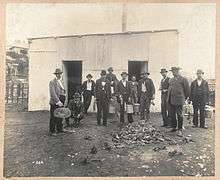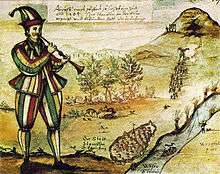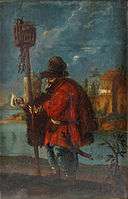Rat-catcher

A rat-catcher is person who practices rat-catching, the occupation of catching rats as a form of pest control. In developed countries the role may be merged with, or the title inflated to, pest control operative or pest technician.
Keeping the rat population under control was practiced in Europe to prevent the spread of diseases to man, most notoriously the Black Plague, and to prevent damage to food supplies.
Anecdotal reports suggest that some rat-catchers in Europe would raise rats instead of catching them in order to increase their eventual payment from the town or city they were employed by. This, and the practice of rat-fights, could have led to rat-breeding and the adoption of the rat as a pet—the fancy rat.
A famous rat-catcher from Victorian England was Jack Black, who is known through Henry Mayhew's interview for London Labour and the London Poor.[1]
Techniques and risks

Rat-catchers would capture rats by hand, often with specially-bred vermin terriers, or with traps. Rats are rarely seen in the open, preferring to hide in holes, haystacks and dark locations. Payment would be high for catching and selling rats to breeders. A rat-catcher's risk of being bitten is high, as is the risk of acquiring a disease from a rat bite.
Modern methods of rat control include traps and poisoned bait, plus more holistic approaches such as introducing predators, reducing litter and the clearing of current or potential nest sites.
Rat-catchers in art
- Rat-catchers in art
 The oldest picture of The Pied Piper of Hamelin, copied from the glass window of the Market Church in Hamelin
The oldest picture of The Pied Piper of Hamelin, copied from the glass window of the Market Church in Hamelin_p039_Fig.18.jpg) Death to the Rats, Edmé Bouchardon
Death to the Rats, Edmé Bouchardon Rat-catcher, 18th century
Rat-catcher, 18th century Rat-catcher, 19th century
Rat-catcher, 19th century Frustrated Rat Catcher (Ittan (Japan, circa 1820-1877), Los Angeles County Museum of Art
Frustrated Rat Catcher (Ittan (Japan, circa 1820-1877), Los Angeles County Museum of Art
Rat-catchers in fiction
Folklore
- A famous fictional rat-catcher was The Pied Piper of Hamelin; different versions of his story have been adapted into a variety of media works.
Comics
- In the DC Comics Universe one of Batman's enemies is the Rat Catcher, formerly Otis Flannegan, who was employed as a real rat-catcher for Gotham City. Rat Catcher occasionally orchestrates rat plagues using his uncanny ability to control rats.[2]
Film
- They make a major appearance in Dario Argento's The Phantom of the Opera (1998 film).
- Ratcatcher (1999), written and directed by Lynne Ramsay, is her debut feature film.
Literature
- Ratcatchers appear in George Eliot's The Mill on the Floss (1860).
- British author Roald Dahl's short story, "The Ratcatcher",[3] was collected in Someone Like You (1953).
See also
References
- ↑ Mayhew, Henry (1851). "Chapter I: The Destroyers of Vermin". London Labour and the London Poor, Volume 3.
- ↑ Batman: Arkham Asylum character bios.
- ↑ Dahl, Raoul (September 13, 2012). Goodreads (Kindle ed.). Penguin. ASIN B008QXLFEI https://www.goodreads.com/book/show/20118223-the-ratcatcher. Missing or empty
|title=(help)
External links
| Wikimedia Commons has media related to Ratcatchers. |
- Full Revelations of a Professional Rat-catcher by Ike Matthews' at Project Gutenberg - an 1898 account of the tricks of the trade, by a British rat-catcher